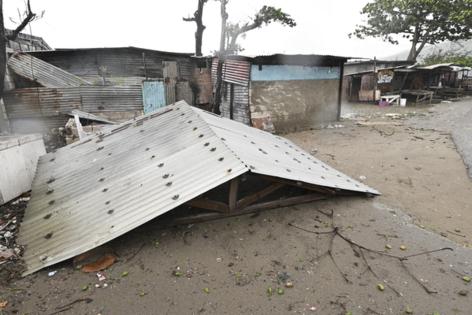'Unprecedented devastation' in Jamaica from Hurricane Melissa hampers aid efforts
Published in Weather News
As a powerful Hurricane Melissa continued its destructive path through the Caribbean and into the Atlantic on Wednesday, Jamaica began the arduous task of trying to assess what one United Nations official described as “tremendous and unprecedented devastation” across the island.
“We have people living in shelters across the country, and at the moment, what we’re seeing in preliminary assessments is a country that’s been devastated to levels never seen before,” said Dennis Zulu, the U.N. resident coordinator in Jamaica with responsibility also for The Bahamas, Bermuda, the Cayman Islands and the Turks and Caicos Islands.
Except for the Cayman Islands, the territories all lie in Melissa’s path as the storm moves northward after thrashing Cuba.
U.N. teams were already out to make an initial assessment of the damage and see what’s most needed, he said. But even as they were working with Jamaican authorities and other partners to determine how expeditiously aid groups could respond to the growing humanitarian need, they faced challenges.
”It’s quite dangerous in some parts,” said Zulu, adding that flooding, fallen debris, downed power lines and loss of electricity and connectivity were hampering efforts.
“Some of the areas really remain unreachable,” he said. “We have serious challenges.”
As many as 1 million people — more than a third of the island’s 2.8 million residents — have been affected by Melissa’s ferocious winds and rains, Zulu estimates.
“I don’t think there’s any single soul on this island who was not affected by Hurricane Melissa, whether it was their roofs being blown out or their gardens,” he said.
One of the strongest storms ever recorded in the Atlantic, Melissa made landfall Tuesday around midday on Jamaica’s western coast. As it barreled across the island, its torrential rains and 185 mph winds ripped off rooftops, flooded farms and plunged communities into despair.
On Wednesday, crews were rescuing residents off rooftops, while Montego Bay, the country’s principal tourist destination, lay submerged. For a nation that has spent years rallying back from the brink of bankruptcy, the scale of the destruction marks a painful moment.
In Black River, where Melissa first landed, and in nearby Treasure Beach, entire communities remained cut off. Already battered by last year’s Hurricane Beryl, residents there now face even more severe losses.
“The area where Hurricane Melissa struck is also the bread basket of Jamaica,” Zulu said, warning that so many food crops and fields were destroyed the country may have issues producing enough food for its people in coming months.
As Zulu spoke, the storm had been downgraded to a Category 2 and was taking aim at the southern Bahamas and Turks and Caicos. But Jamaica remained under threat as rains continued to pour over already saturated hillsides, increasing the possibility of landslides.
“This impacts us quite badly, because we can’t undertake the needed assessments that we need to do. And we can’t get the resources that these people need in those areas that have been affected,” he said. The U.N., for the moment, would need to rely on drones and satellite imaging to ascertain the level of damage.
Teams on standby
The Caribbean Disaster and Emergency Management Agency said it had teams from some of its 20-member participating countries “on standby” to deploy. But they were waiting on the main international airport in Kingston to be operational, executive director Elizabeth Riley said.
“The access is an important part of the response efforts. In fact, it’s the first element,” she said. “What we need to ensure is that when we respond, we are responding in a safe environment. So one of the critical first steps in the aftermath of a significant disaster is that we have to look at the logistics of how we access the country.”
Riley said while the government of Jamaica was prioritizing access to Norman Manley International Airport in Kingston for relief operations, partners like the European Union were assisting with logistics. A French vessel, she added, was currently docked at the port of Bridgetown, Barbados, where it’s being loaded to transport supplies to Jamaica.
“I’m confident that the relief efforts will begin immediately following the opening of the airport and the port,” Riley said.
Riley stressed that relief efforts are being coordinated with the Jamaican government, which is in charge of controlling what resources pour in, and on Tuesday launched a portal to receive aid and coordinate the response after the storm.
Melissa’s slow trek across the southern Caribbean had an upside, aid experts said. It gave them and the Jamaican government time to prepare.
In the walk-up to the storm’s devastating arrival in Jamaica, Riley said disaster experts ran various potential scenarios.
“Unfortunately, the scenario of a direct impact of Jamaica is what played out,” she said.
Late Wednesday, Hurricane Melissa had been downgraded to a Category 1 with 90 mph wind. As of 5 p.m., it was just off the eastern coast of Long Island in The Bahamas.
_____
©2025 Miami Herald. Visit miamiherald.com. Distributed by Tribune Content Agency, LLC.







Comments